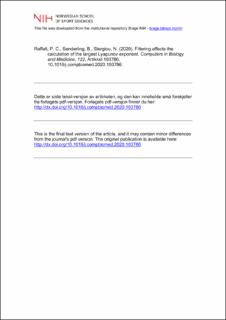| dc.contributor.author | Raffalt, Peter Christian | |
| dc.contributor.author | Senderling, Benjamin | |
| dc.contributor.author | Stergiou, Nicholas | |
| dc.date.accessioned | 2021-04-28T09:23:35Z | |
| dc.date.available | 2021-04-28T09:23:35Z | |
| dc.date.created | 2020-08-24T13:21:47Z | |
| dc.date.issued | 2020 | |
| dc.identifier.citation | Computers in Biology and Medicine. 2020, 122(2020), Artikkel 103786. | en_US |
| dc.identifier.issn | 0010-4825 | |
| dc.identifier.uri | https://hdl.handle.net/11250/2740102 | |
| dc.description | I Brage finner du siste tekst-versjon av artikkelen, og den kan inneholde ubetydelige forskjeller fra forlagets pdf-versjon. Forlagets pdf-versjon finner du på www.sciencedirect.com / In Brage you'll find the final text version of the article, and it may contain insignificant differences from the journal's pdf version. The original publication is available at www.sciencedirect.com | en_US |
| dc.description.abstract | The calculation of the largest Lyapunov exponent (LyE) requires the reconstruction of the time series in an N-dimensional state space. For this, the time delay (Tau) and embedding dimension (EmD) are estimated using the Average Mutual Information and False Nearest Neighbor algorithms. However, the estimation of these variables (LyE, Tau, EmD) could be compromised by prior filtering of the time series evaluated. Therefore, we investigated the effect of filtering kinematic marker data on the calculation of Tau, EmD and LyE using several different computational codes. Kinematic marker data were recorded from 37 subjects during treadmill walking and filtered using a low pass digital filter with a range of cut-off frequencies (23.5–2Hz). Subsequently, the Tau, EmD and LyE were calculated from all cut-off frequencies. Our results demonstrated that the level of filtering affected the outcome of the Tau, EmD and LyE calculations for all computational codes used. However, there was a more consistent outcome for cut-off frequencies above 10 Hz which corresponded to the optimal cut-off frequency that could be used with this data. This suggested that kinematic data should remain unfiltered or filtered conservatively before calculating Tau, EmD and LyE. | en_US |
| dc.language.iso | eng | en_US |
| dc.subject | nonlinear analysis | en_US |
| dc.subject | cut-off frequency | en_US |
| dc.subject | walking | en_US |
| dc.subject | smoothing | en_US |
| dc.subject | biomechanics | en_US |
| dc.title | Filtering affects the calculation of the largest Lyapunov exponent | en_US |
| dc.type | Peer reviewed | en_US |
| dc.type | Journal article | en_US |
| dc.description.version | acceptedVersion | en_US |
| dc.source.pagenumber | 9 | en_US |
| dc.source.volume | 122 | en_US |
| dc.source.journal | Computers in Biology and Medicine | en_US |
| dc.identifier.doi | 10.1016/j.compbiomed.2020.103786 | |
| dc.identifier.cristin | 1824797 | |
| dc.description.localcode | Institutt for fysisk prestasjonsevne / Department of Physical Performance | en_US |
| cristin.ispublished | true | |
| cristin.fulltext | postprint | |
| cristin.qualitycode | 1 | |
